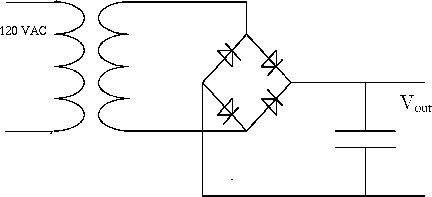Full-wave rectifier with a 12 V transformer.
- Calculate what the ripple will be for the full-wave rectifier both with a 1k load and with no load.
- What should the ripple frequency be?
- How will the ripple change if you double or halve the load current?
Analyze the discrete component regulator.
- Find the size of resistor that is in series with the zener (assume the unregulated voltage is 12V; during lab you will need to change this after you measure your voltage).
- Find the voltage at each point in the circuit.
- Find each current in the circuit. Do this for both loads.
- How much power is being dissipated in the load, and how much in the regulator transistor?
- How does this compare with the power rating of the transistor?
- How much base current is required to drive the 180-ohm load if the transistor has a beta of 20? How much current does this leave to go through the zener diode? The circuit stops regulating when the zener current drops to zero. At what value of Rload would this occur at?
Analyze the regulator with short circuit.
- Find the voltages, currents and powers when the output is shorted.
- Find the R2 needed for the 317 regulator. Use 240 ohms for R1
Full-wave Rectifier.
The source of unregulated
voltage in a power supply is usually a half-or full-wave rectified
sine wave from a transformer. For this lab we will use a full-wave
bridge rectifier, as shown below. Construct the rectifier using
1N4007 rectifier diodes and a 100 uF filter capacitor (be
sure to observe the polarity of the capacitor). Do not short
out the transformer secondary.

Measure the output voltage with no load resistance using
the oscilloscope and the DMM.
Measure the peak-to-peak ripple first with and then without a load resistor of 1
kilohm. (Use your scope in AC
coupling mode to do this.) What is the observed ripple frequency?
For the rest of the experiment, put the unregulated
voltage on one of your breadboard busses. Remove the load. You
will put the load on the regulated voltage later.
Discrete Component Regulators.
An emitter follower circuit
can be used to buffer the output of a simple zener voltage regulator,
as shown below. We will use a power transistor for the emitter
follower, the TIP31, because of the power demands that we will
place on the circuit. Choose R such that a minimum of 12 mA
of current will flow through the zener diode.

What is the expected output
voltage of the regulator? Construct and test the circuit, using
the unregulated output of your rectifier as the supply voltage
for the circuit, and with Rload = 1 kilohm, as before.
Measure and note the various voltages on your schematic. Then
do the following:
- Measure the p-p ripple voltages at the different points. Why is the output ripple less than that of the unregulated source? How much of the output ripple is due to the ripple across the zener diode? Compute the `ripple rejection', defined as the ratio of the p-p output ripple to the p-p input ripple.
- Apply a 180-ohm load to the output of the appropriate wattage rating. What happens to the output voltage and to the ripple, and why? The ripple voltage should change at all points in the circuit. What is the load regulation?
Short Circuit Protection
The regulator can be protected
against a short circuit on its output by adding another transistor,
as shown below. If the output current exceeds a certain value,
Q2 is turned on and `robs' Q1 of its base current. Build this circuit.
Integrated Circuit Regulators.
The circuit that you have
just tested is the basic technique employed in the LM105 integrated
circuit adjustable voltage regulator. Another IC regulator which
is somewhat easier to use is the LM317. It is a three-terminal
package in which the output is regulated to be 1.25 volts greater
than the `adjust' input, which is a high impedance input. For
this regulator, Vout = 1.25 (1 + R2 / R1).
Use 240 ohms for R1 as suggested in the spec sheet.

Design a 5 volt regulator
and build and test the circuit, using the unregulated output from
your rectifier as the input to the regulator. Measure the load
regulation and ripple rejection.
